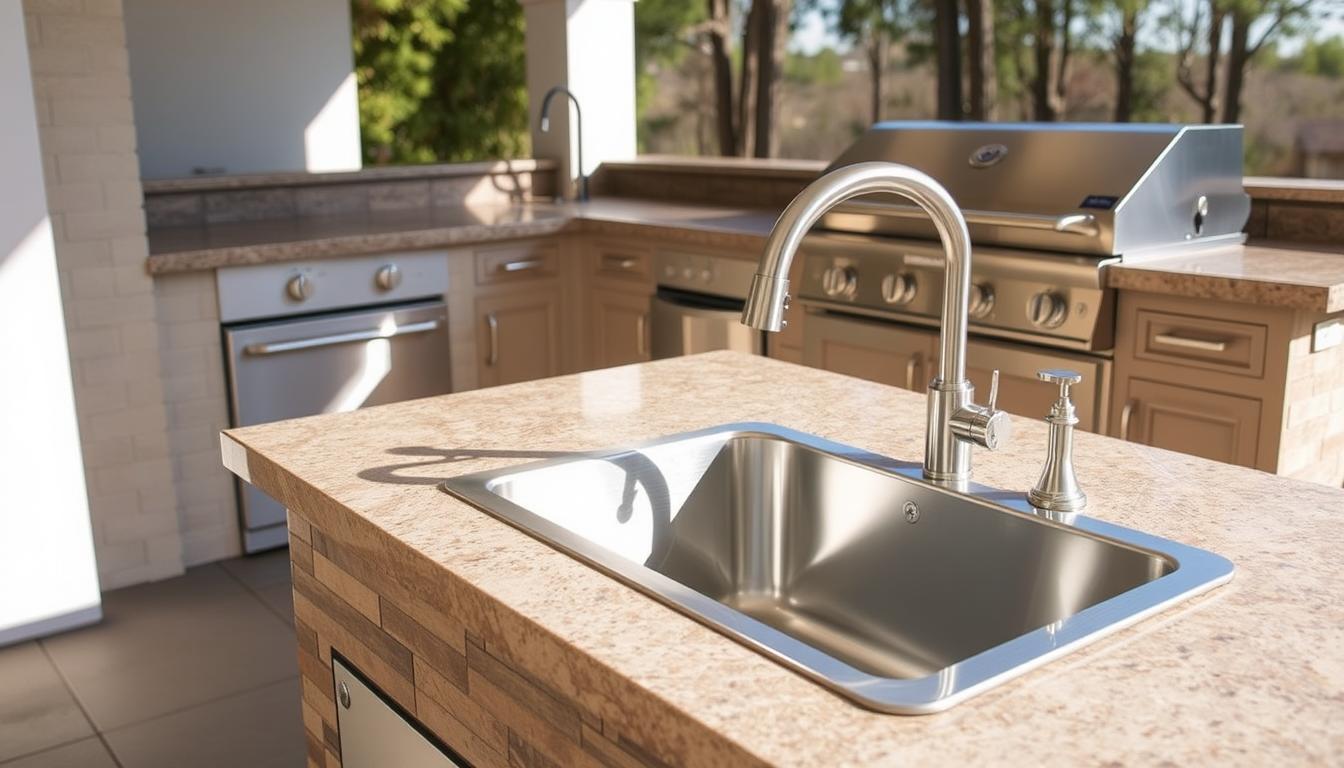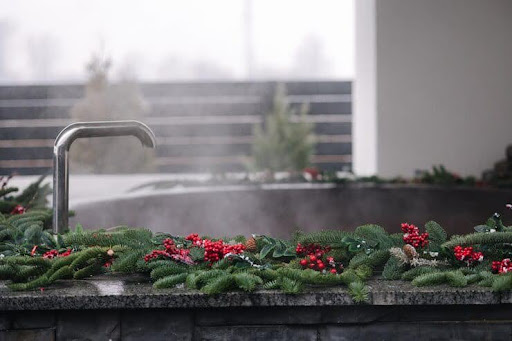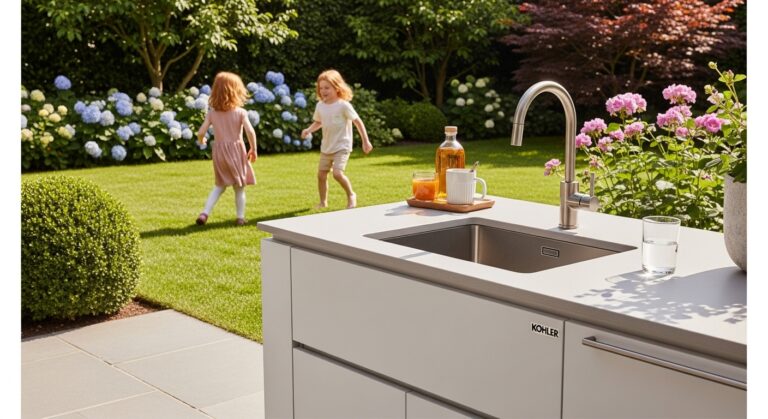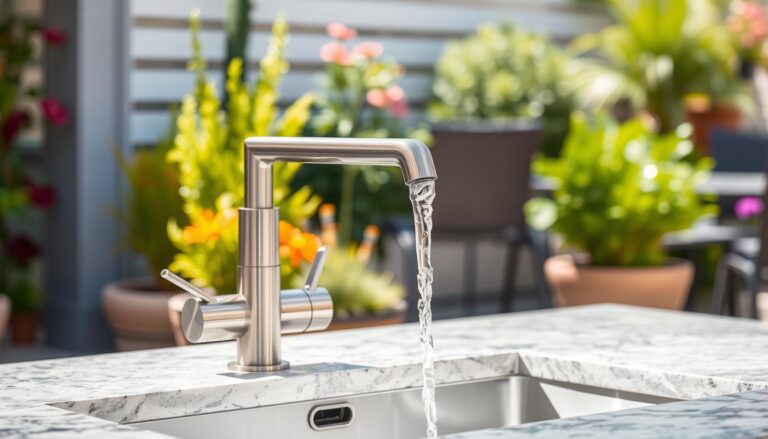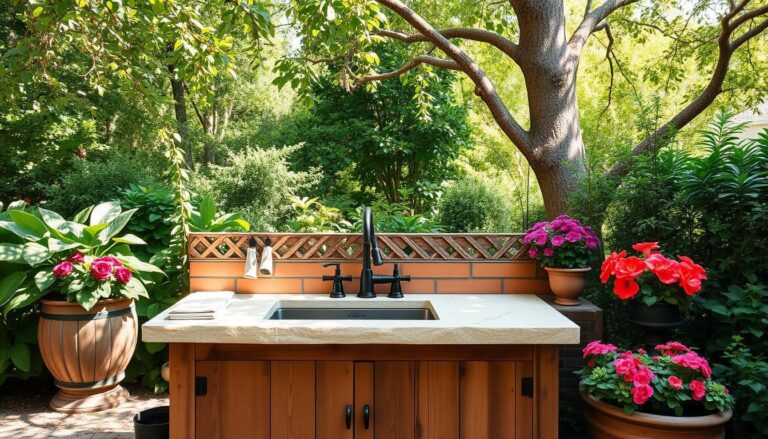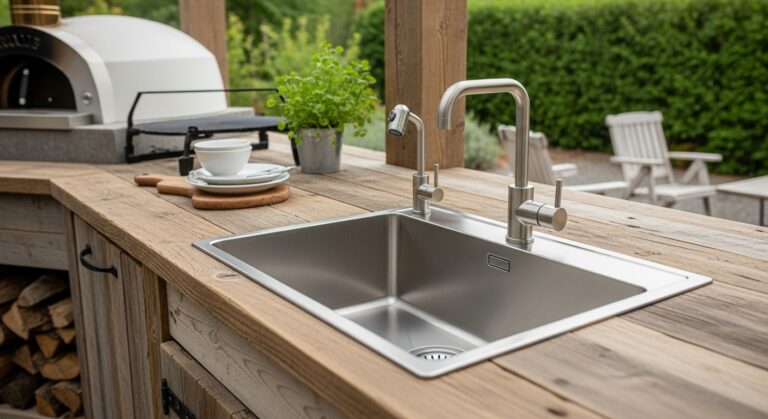The Outdoor Kitchen Sink: A Buyer’s Guide
Benefits of an Outdoor Kitchen Sink
Convenience and Functionality
An outdoor kitchen sink eliminates constant trips indoors while cooking or entertaining. You can wash vegetables, rinse dishes, and clean up spills without leaving your guests. This seamless workflow makes outdoor cooking more enjoyable and efficient.
Improved Hygiene
Having a dedicated handwashing station outdoors is essential for food safety. After handling raw meats or garden soil, you can immediately wash your hands before continuing food preparation, reducing cross-contamination risks.
Enhanced Entertainment Value
A well-designed outdoor kitchen with a proper sink elevates your entertaining capabilities. Guests can gather around while you prepare meals, creating an interactive social experience that’s impossible to achieve with indoor cooking.
Increased Home Value
Outdoor kitchens with quality fixtures like weatherproof sinks are increasingly desirable features for homebuyers. Installing a durable, attractive outdoor kitchen sink can boost your property’s appeal and market value.
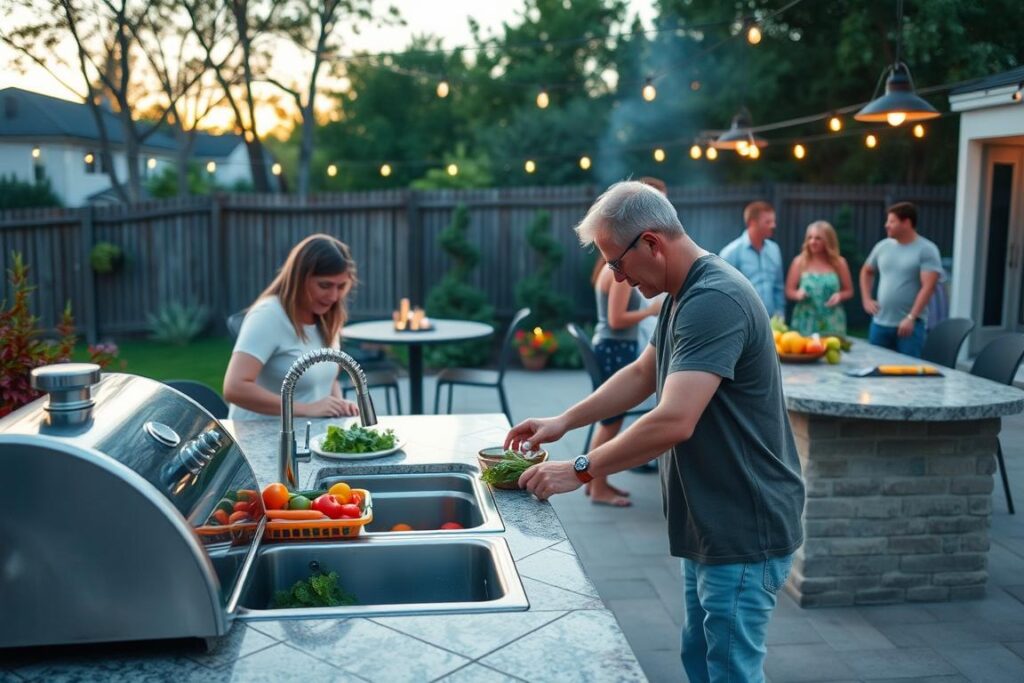
Key Features to Consider When Choosing an Outdoor Kitchen Sink
Material Options
The material of your outdoor kitchen sink is perhaps the most critical decision, as it affects durability, maintenance requirements, and aesthetics. Here’s how the most popular options compare:
| Material | Durability | Maintenance | Cost Range | Best For |
| Stainless Steel (304 Grade) | High | Low | $150-$600 | All-purpose use, moderate climates |
| Stainless Steel (316 Marine Grade) | Very High | Very Low | $350-$1,200 | Coastal areas, harsh environments |
| Copper | High | Medium | $500-$1,500 | Luxury aesthetics develops patina |
| Granite Composite | High | Medium | $300-$900 | Heat resistance, color options |
| Concrete | Medium | High | $400-$1,000 | Custom designs, rustic aesthetics |
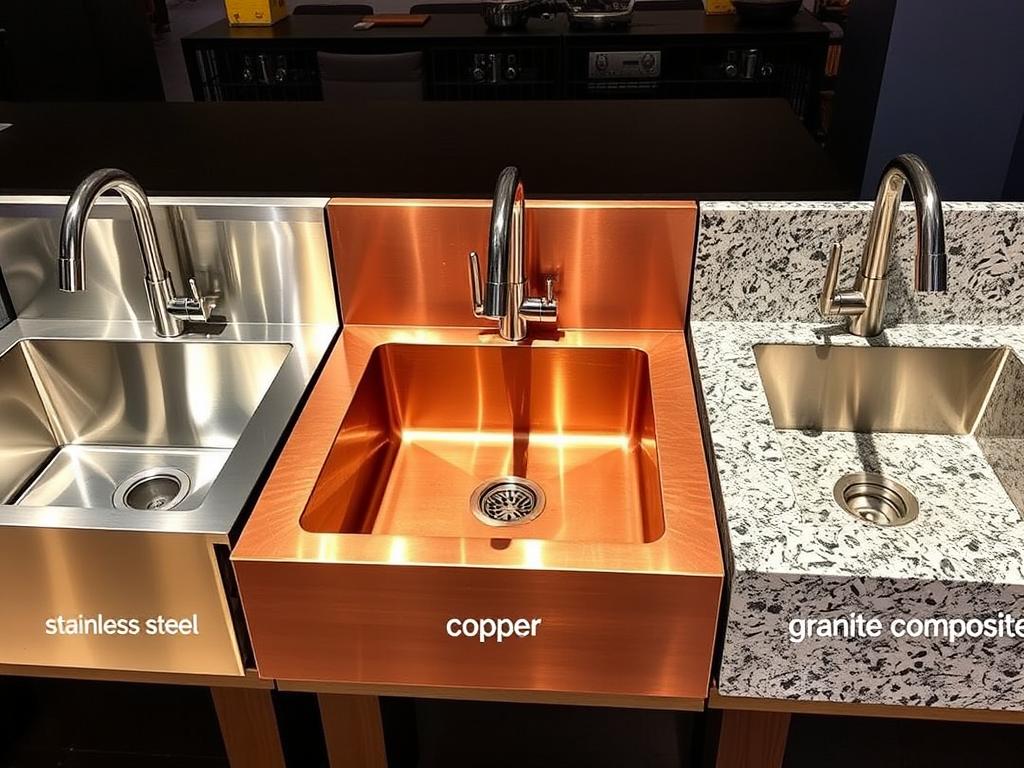
Size and Configuration
Outdoor kitchen sinks come in various sizes and configurations to suit different needs and spaces:
Single Bowl vs. Double Bowl
Single-bowl sinks are more commonly used in outdoor kitchens, offering simplicity and sufficient space for most tasks. Double bowl configurations provide separate areas for washing and rinsing, but require more counter space.
Depth Considerations
Deeper sinks (8-10 inches) contain splashes better and accommodate larger items, while shallower models (6-8 inches) may be more comfortable for extended use and take up less space under the counter.
Width and Length
Standard outdoor sink widths range from 15 to 33 inches. Smaller bar-sized sinks (15-21 inches) work well for limited spaces, while full-sized kitchen sinks (25-33 inches) offer more versatility for food prep and cleanup.
Workstation Features
Many modern outdoor sinks include workstation features like cutting boards, colanders, and drying racks that fit over the basin, maximizing functionality in limited counter space.
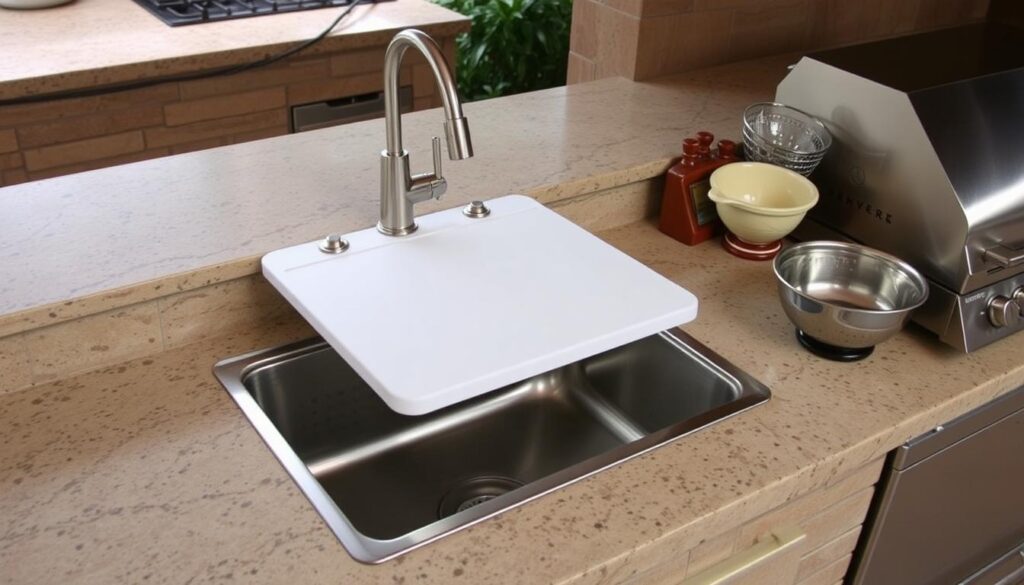
Installation Types
The installation method affects both aesthetics and practicality. Consider these common options:
Drop-In (Top-Mount)
The rim of the sink sits on top of the counter with the basin dropping below. This is the easiest to install and works with any countertop material, but creates a lip that can collect debris.
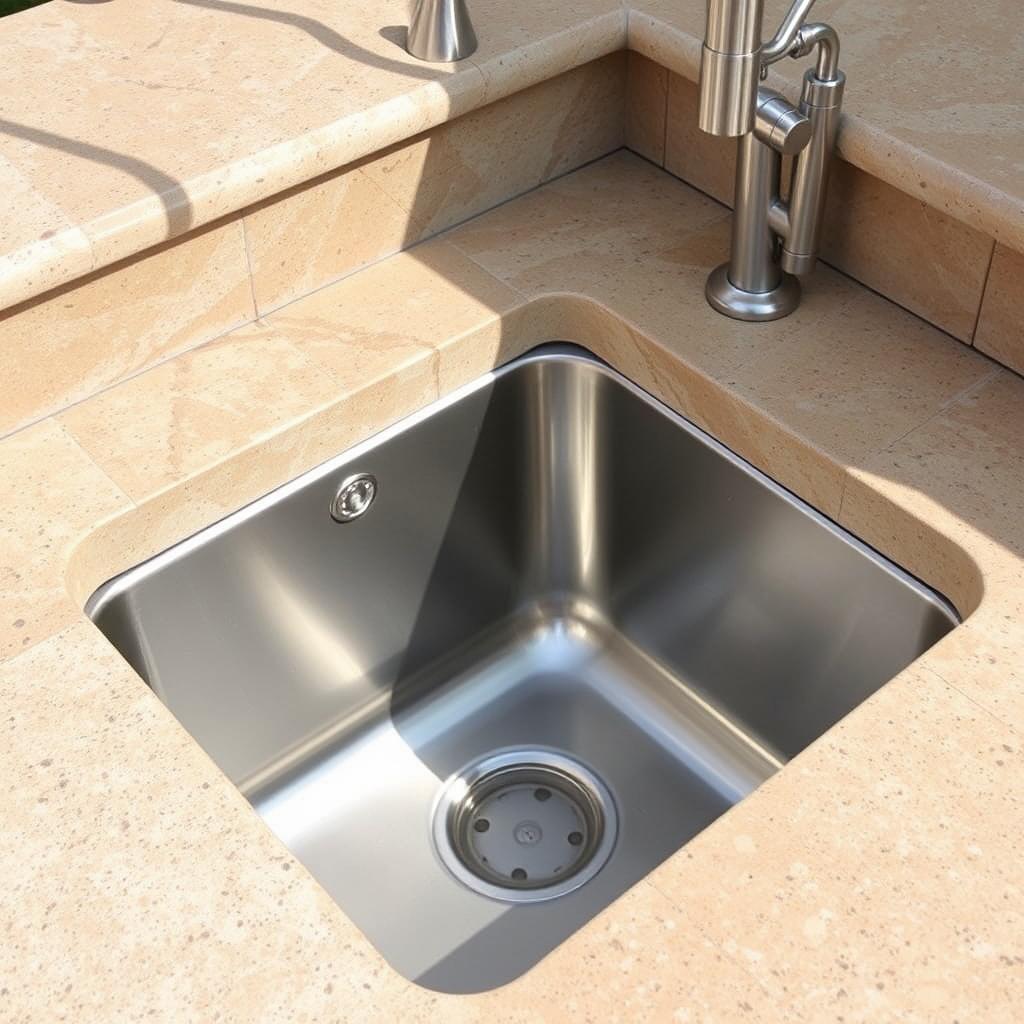
Undermount
The sink attaches beneath the counter, creating a seamless look and making it easy to wipe debris directly into the sink. Requires solid countertop materials like stone, concrete, or solid surface.
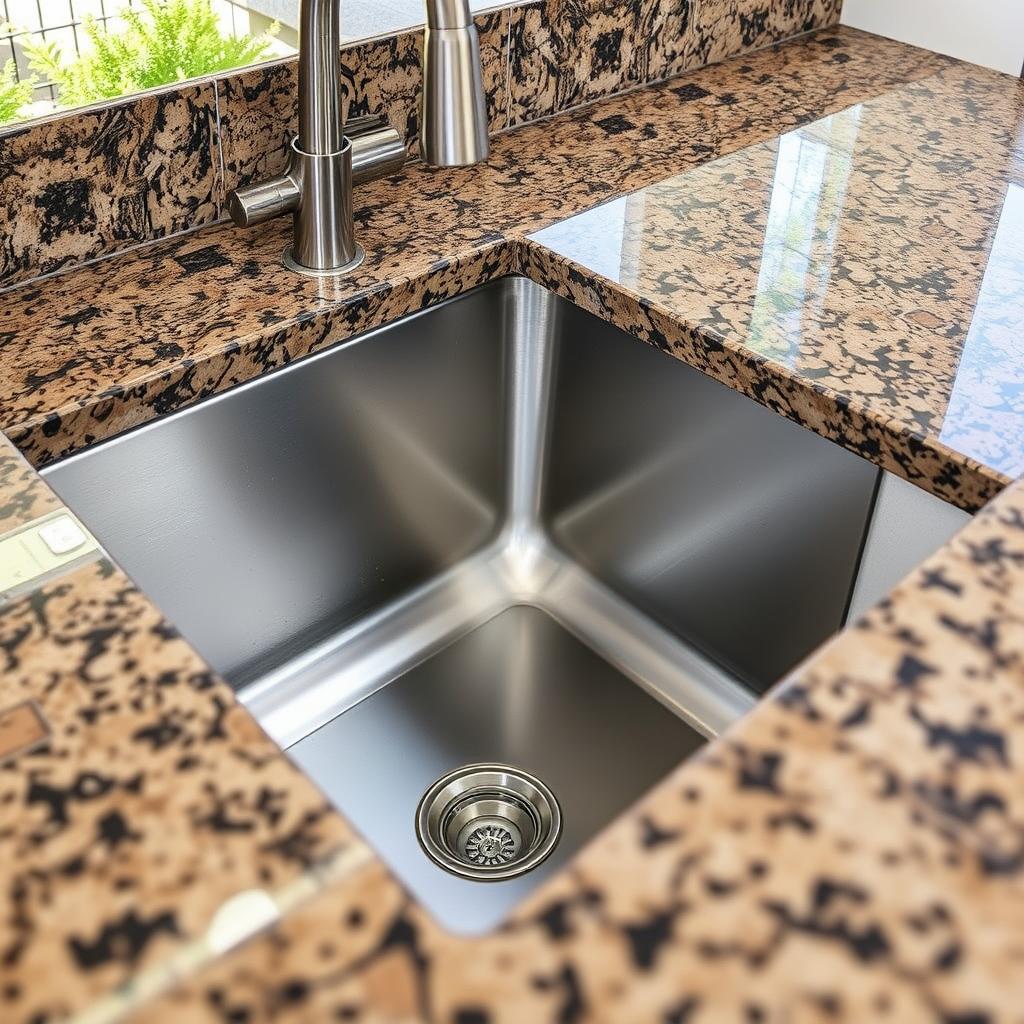
Farmhouse (Apron-Front)
The front of the sink is exposed and sits flush with the front of the cabinetry. This statement-making design offers deep basins and a distinctive look, but requires specialized cabinetry.
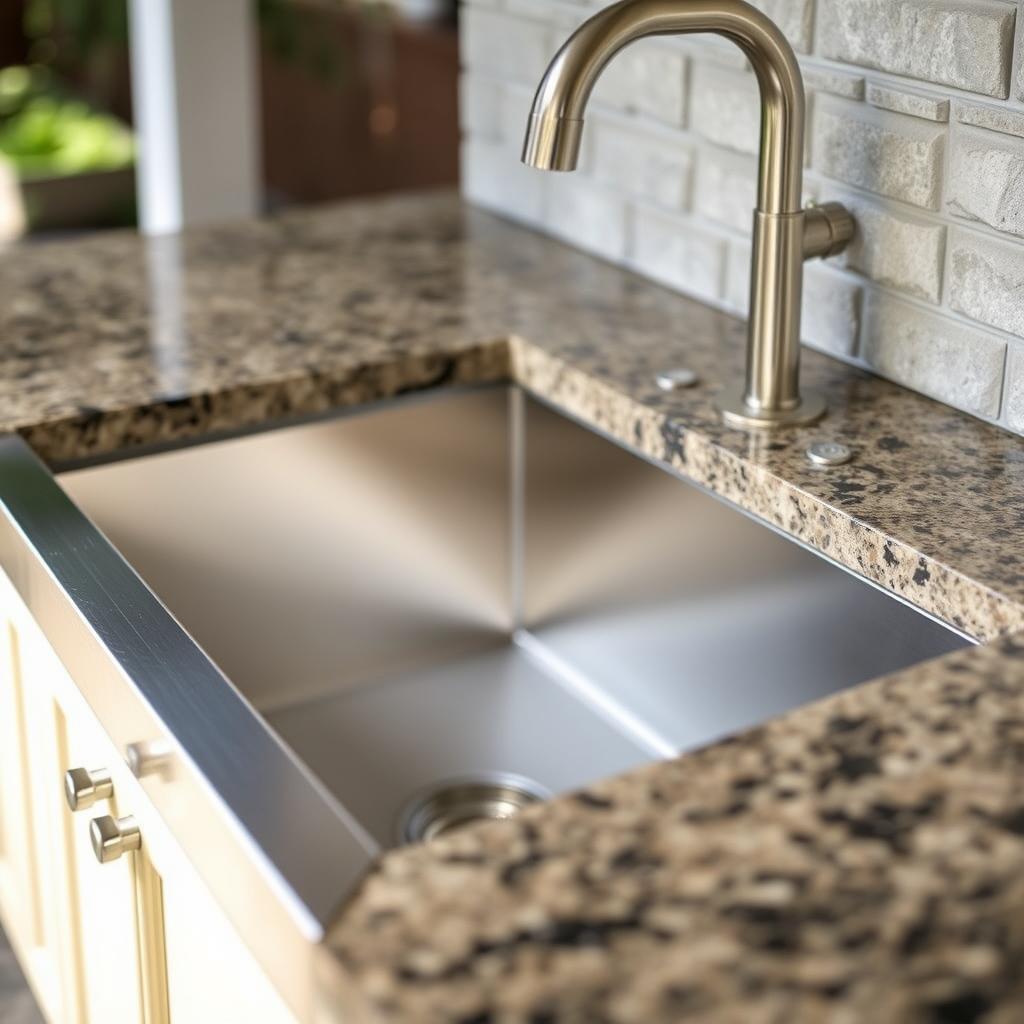
Weather Resistance Features
For outdoor applications, weather resistance is crucial. Look for these specific features:
- Marine-grade stainless steel (316 grade) for superior corrosion resistance, especially in coastal areas
- UV-resistant materials that won’t fade or degrade with sun exposure
- Insulated sink basins that help prevent condensation and temperature transfer
- Protective covers or lids to shield the sink when not in use
- Drainage systems are designed to prevent freezing in colder climates
- Reinforced mounting hardware that won’t rust or deteriorate outdoors
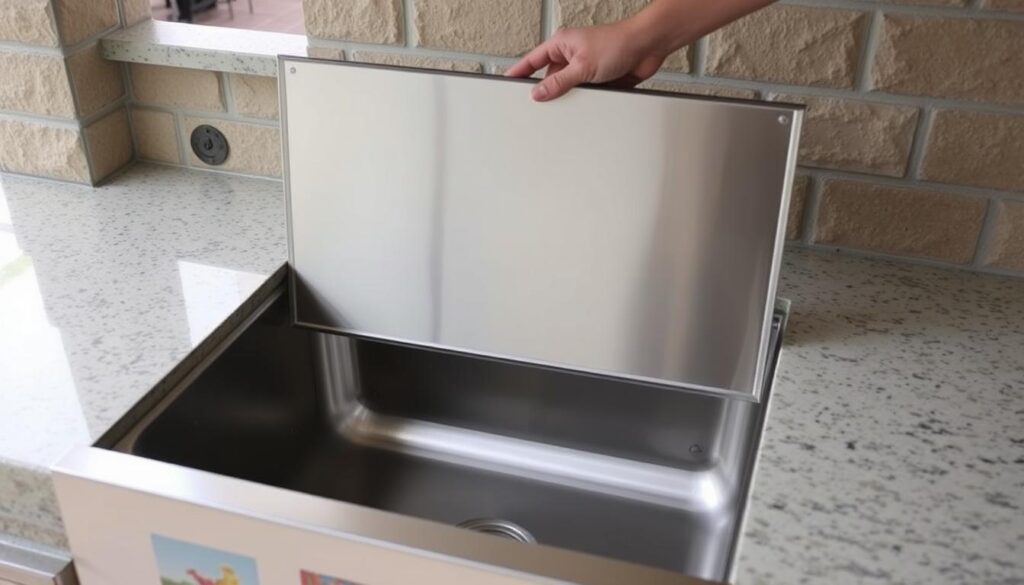
Faucet Compatibility
The right faucet completes your outdoor sink setup. Consider these factors:
Water Supply Options
Determine whether you need hot and cold water or just cold. Hot water requires additional plumbing but greatly enhances functionality for washing dishes and food prep.
Mounting Configuration
Check how many faucet holes your sink provides (typically 1-4) and choose a compatible faucet. Some sinks come with pre-drilled holes, while others allow custom drilling.
Material and Finish
Select weatherproof materials like marine-grade stainless steel or brass with special outdoor finishes. Avoid finishes that can’t withstand UV exposure or temperature fluctuations.
Style and Function
Popular outdoor faucet styles include pull-down sprayers, pot fillers, and pre-rinse commercial styles. Consider height clearance and ease of operation with wet or dirty hands.
Top Recommended Outdoor Kitchen Sinks
After reviewing dozens of models, we’ve identified these standout options that balance quality, features, and value:
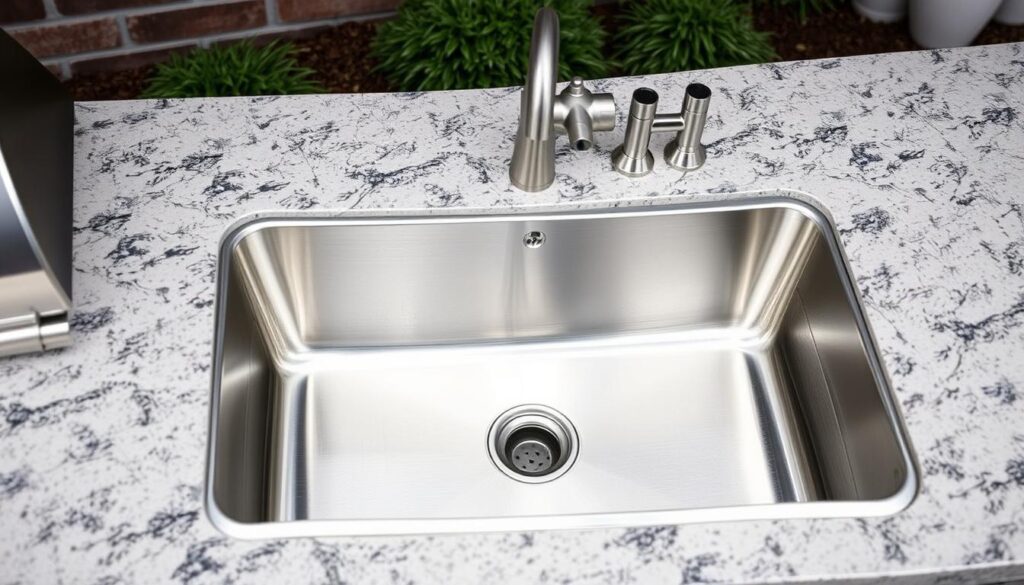
BBQGuys Signature 21-Inch Outdoor Rated Stainless Steel Sink
Best Overall
This versatile 304-grade stainless steel sink includes a hot/cold faucet and offers excellent corrosion resistance. The 21-inch width provides ample workspace while fitting in most outdoor counters. Features include sound-dampening pads and a brushed finish that hides water spots and fingerprints.
- Price Range: $550-$650
- Material: 18-gauge 304 stainless steel
- Installation Type: Drop-in
- Includes: Hot/cold faucet, sink strainer, mounting hardware
- Best For: All-purpose outdoor kitchens with water hookups
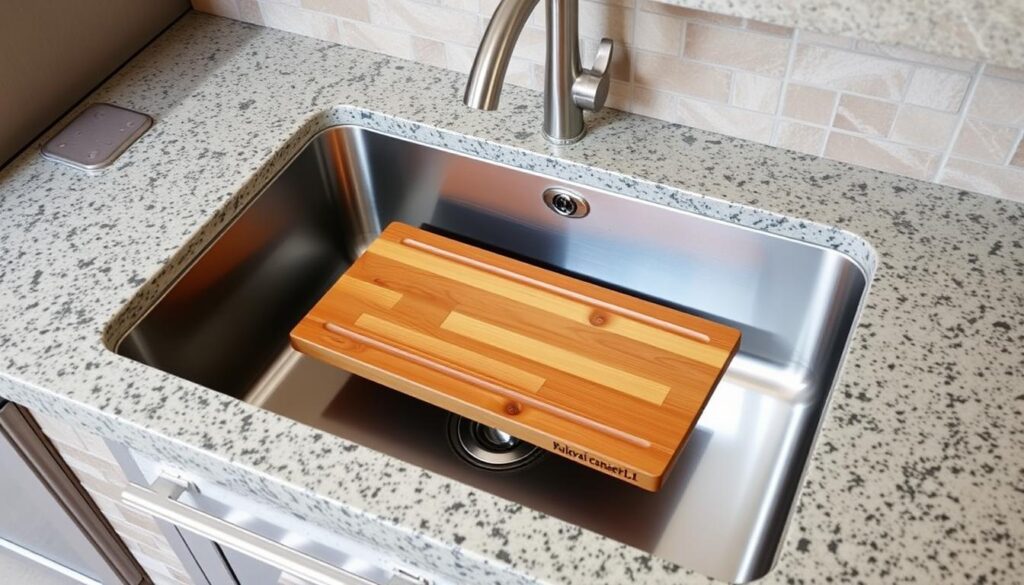
Ruvati 15 x 15 inch Marine Grade T-316 Workstation Sink
Premium Pick
This compact but feature-rich sink uses marine-grade 316 stainless steel for superior corrosion resistance in any climate. The workstation design includes a solid wood cutting board and roll-up rack that fit over the sink, maximizing functionality in a limited space.
- Price Range: $350-$450
- Material: 16-gauge T-316 marine grade stainless steel
- Installation Type: Topmount
- Includes: Cutting board, roll-up rack, basket strainer, mounting clips
- Best For: Coastal areas, small outdoor kitchens, boats, and RVs
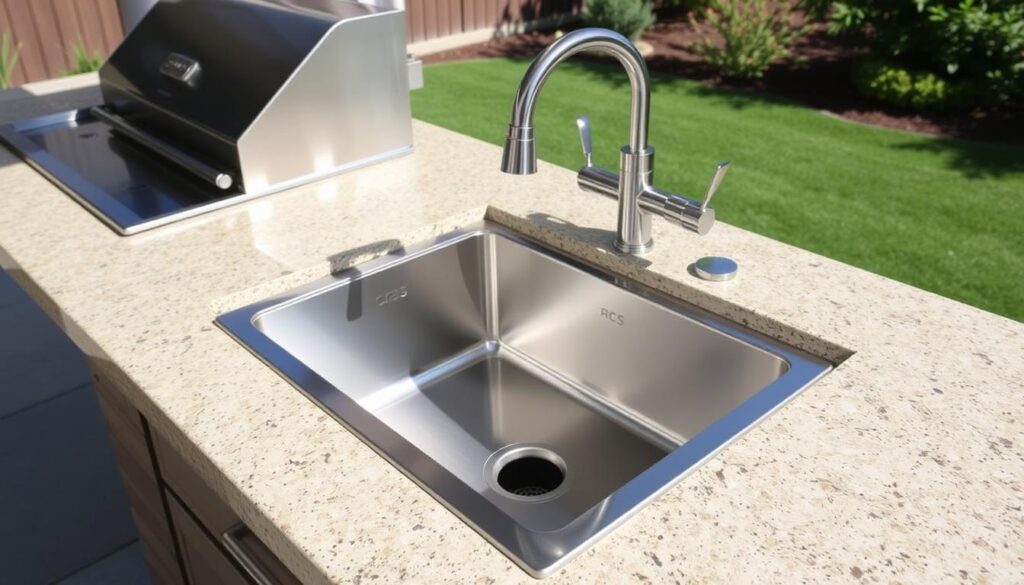
RCS 15 X 15 Outdoor Rated Stainless Steel Sink
Best Value
This compact and affordable sink is perfect for smaller outdoor kitchens or bar areas. Despite its budget-friendly price, it includes a quality hot/cold faucet and is constructed from weather-resistant stainless steel that stands up to outdoor conditions.
- Price Range: $200-$250
- Material: 18-gauge 304 stainless steel
- Installation Type: Drop-in
- Includes: Hot/cold faucet, drain assembly
- Best For: Budget-conscious buyers, smaller outdoor spaces
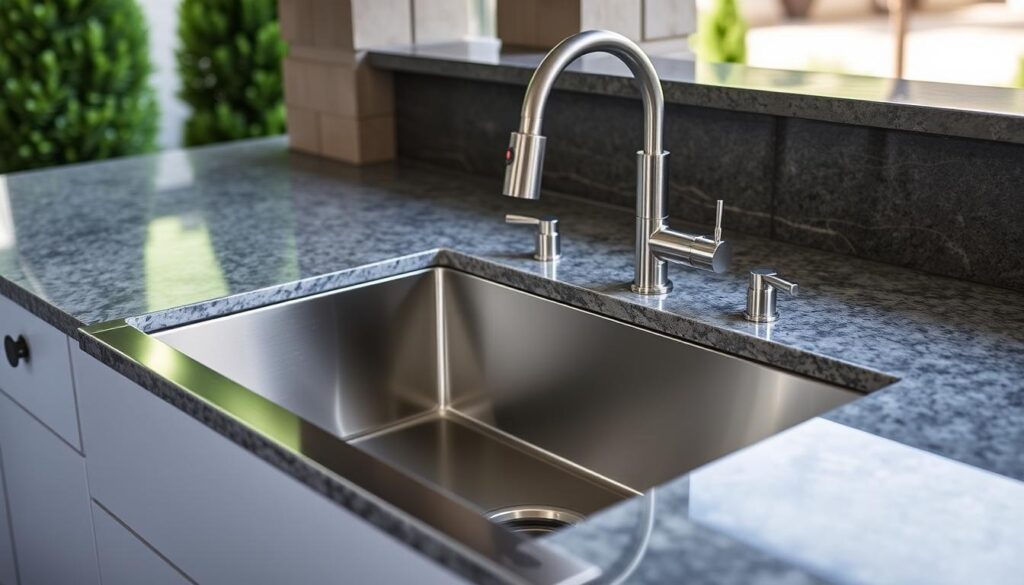
Lynx Professional 18-Inch Outdoor Rated Stainless Steel Sink
Luxury Choice
This premium sink represents the pinnacle of outdoor kitchen fixtures. Constructed from heavy-gauge stainless steel with seamless welded corners, it’s built to last a lifetime. The professional-grade construction includes insulated walls to maintain water temperature.
- Price Range: $1,400-$1,600
- Material: 16-gauge 304 stainless steel with seamless welding
- Installation Type: Drop-in
- Includes: Sink only (faucet sold separately)
- Best For: Luxury outdoor kitchens, professional-grade installations
Installation Considerations
DIY vs. Professional Installation
Installing an outdoor kitchen sink involves both plumbing and potentially electrical work. Here’s what to consider when deciding whether to DIY or hire a professional:
DIY Installation
- Cost savings on labor
- Suitable for those with basic plumbing experience
- Drop-in sinks are relatively straightforward to install
- Many manufacturers provide detailed instructions
Professional Installation
- Ensures proper water supply and drainage
- Required for complex undermount or farmhouse installations
- Professionals understand local building codes
- Often includes a warranty on the installation work
Basic Installation Requirements
Whether you DIY or hire a pro, these are the essential components needed for a functional outdoor kitchen sink:
- Water supply lines (hot and cold if desired)
- Drainage system connected to home plumbing or dedicated drainage
- P-trap to prevent odors from backing up
- Shut-off valves for winterization in cold climates
- Appropriate cabinetry or support structure
- Weatherproof electrical outlet if using a garbage disposal
- Countertop with appropriate cutout for your sink model
Location Planning
Strategic placement of your outdoor sink maximizes its functionality:
Near the Grill
Positioning your sink close to the cooking area creates an efficient workflow for food preparation and cleanup. Aim for a location within 2-3 steps of your grill or cooktop.
Access to Plumbing
Consider the location of existing water lines and drainage. Installing the sink along an exterior wall of your home can significantly reduce plumbing costs and complexity.
Weather Protection
If possible, position the sink under a covered area to protect it from direct exposure to rain, snow, and intense sunlight, extending its lifespan and improving usability in various weather conditions.

Maintenance and Care
Routine Cleaning
Proper maintenance ensures your outdoor kitchen sink remains functional and attractive for years:
Stainless Steel Sinks
- Clean regularly with mild dish soap and warm water
- Wipe in the direction of the grain to prevent scratches
- Use a baking soda paste for stubborn stains
- Apply stainless steel cleaner/polish monthly
- Avoid abrasive cleaners, steel wool, and bleach
Other Materials
- Copper: Clean with a specialized copper cleaner or vinegar/salt solution
- Granite Composite: Use mild soap and a soft cloth; avoid acidic cleaners
- Concrete: Apply sealer every 1-2 years; clean with pH-neutral cleaner
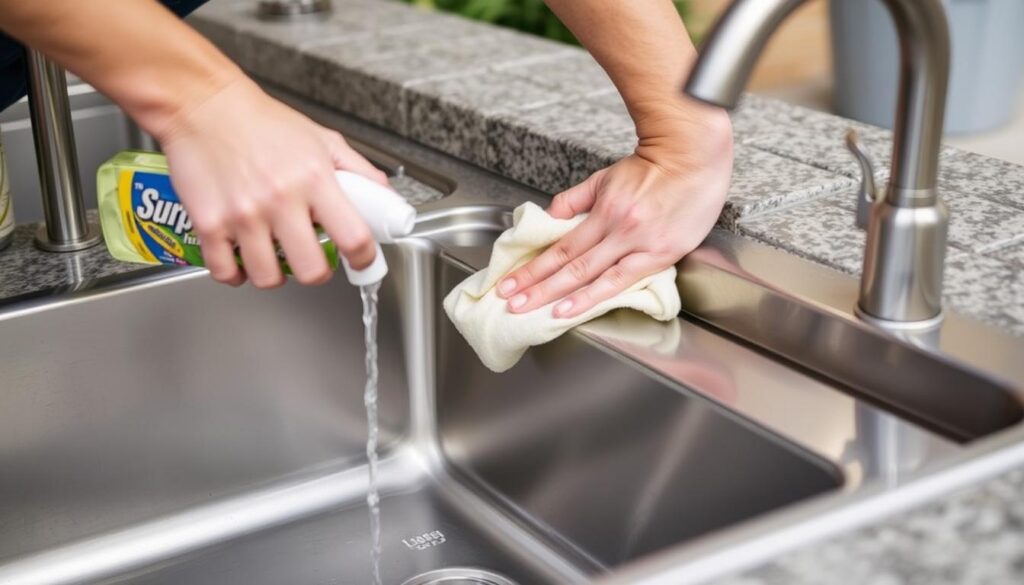
Seasonal Maintenance
Winterization (Cold Climates)
In regions where temperatures drop below freezing, proper winterization prevents damage to your outdoor sink and plumbing:
- Shut off the water supply valves to the outdoor sink
- Disconnect and drain water supply lines
- Pour RV antifreeze (not automotive) down the drain
- Cover the sink with a weatherproof cover or tarp
- If possible, remove the faucet and store it indoors
Spring Preparation
When warm weather returns, prepare your sink for the outdoor cooking season:
- Remove covers and inspect for any winter damage
- Reconnect water lines and check for leaks
- Flush the system thoroughly to remove antifreeze
- Clean the sink thoroughly and apply appropriate protectants
- Check and tighten any loose fittings or hardware
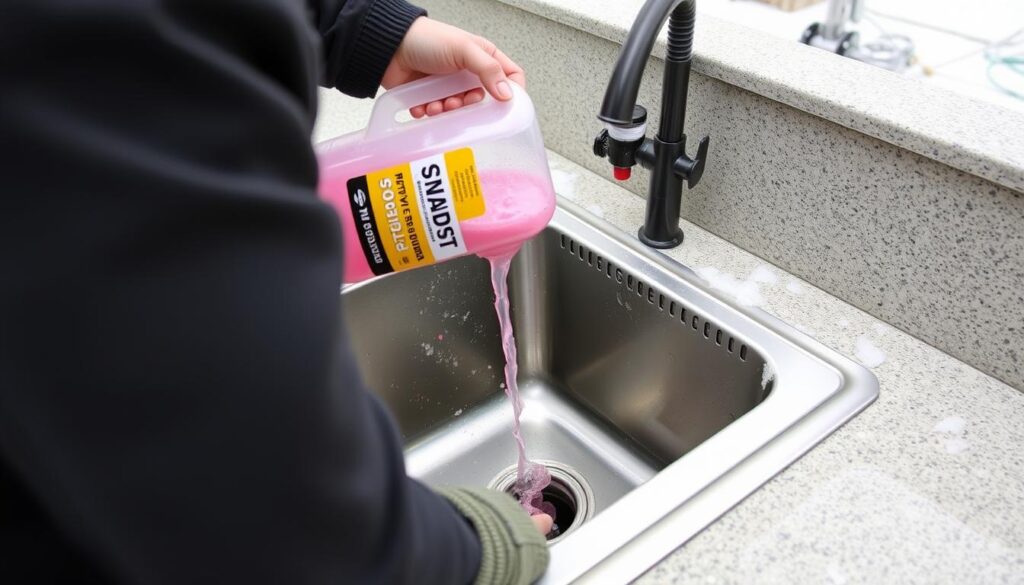
Extending Lifespan
These practices help maximize the durability of your outdoor kitchen sink:
- Use sink covers when not in use to protect from UV exposure and debris
- Apply appropriate protectants (stainless steel polish, copper wax, etc.) seasonally
- Install a water filtration system to prevent mineral buildup in areas with hard water
- Repair small scratches or chips promptly to prevent further deterioration
- Keep trees and plants trimmed back to minimize debris and sap accumulation
- Consider a sink grid to protect the basin bottom from scratches
Budget Considerations
Outdoor kitchen sinks span a wide price range depending on materials, features, and installation requirements. Understanding the cost breakdown helps you plan effectively:
| Budget Level | Sink Cost Range | Features | Installation Cost | Total Investment |
| Entry-Level | $150-$300 | Basic 304 stainless steel, simple design, limited accessories | $200-$400 | $350-$700 |
| Mid-Range | $300-$800 | Higher gauge stainless, workstation features, quality faucet included | $400-$800 | $700-$1,600 |
| Premium | $800-$1,500 | 316 marine-grade stainless, copper, or specialty materials, comprehensive accessories | $800-$1,200 | $1,600-$2,700 |
| Luxury | $1,500-$3,000+ | Custom designs, professional-grade construction, integrated systems | $1,200-$2,000+ | $2,700-$5,000+ |
Cost-Saving Tips
Maximize value without compromising quality with these budget-friendly approaches:
- Position your sink near existing plumbing to reduce installation costs
- Consider a drop-in sink, which is typically easier and less expensive to install
- Look for package deals that include faucets and accessories
- Shop during end-of-season sales (typically fall and winter)
- Focus on durability over extra features for long-term value
- DIY installation if you have the necessary skills
- Choose a smaller sink if you have budget constraints
- Invest in a quality sink cover to extend the lifespan and protect your investment
Conclusion
An outdoor kitchen sink is more than just a convenience—it’s a transformative addition that enhances functionality, improves workflow, and elevates the entire outdoor cooking experience. By carefully considering material options, size requirements, installation methods, and budget constraints, you can select the perfect sink that balances durability, aesthetics, and functionality for your specific needs.
Remember that investing in quality materials and proper installation pays dividends in longevity and performance. Whether you choose a compact bar sink for occasional use or a professional-grade workstation for serious outdoor cooking, the right outdoor kitchen sink becomes the heart of your outdoor entertaining space.
With proper maintenance and care, your outdoor kitchen sink will provide years of reliable service, making every backyard gathering more enjoyable and convenient. Take the time to research your options, consider your specific requirements, and select a sink that will stand up to the elements while complementing your outdoor kitchen design.
Frequently Asked Questions
Can I use an indoor sink for my outdoor kitchen?
While technically possible, it’s not recommended. Indoor sinks aren’t designed to withstand outdoor elements like UV exposure, temperature fluctuations, and moisture. They’ll deteriorate much faster and may develop rust or corrosion. Outdoor-rated sinks use materials specifically chosen for weather resistance and longevity in exterior environments.
How do I prevent my outdoor sink pipes from freezing?
To prevent freezing: 1) Install shut-off valves indoors and drain water lines before winter, 2) Use insulated pipes or heat tape for exposed plumbing, 3) Consider a dry sink setup with a removable catch basin for cold climates, 4) Pour RV antifreeze (not automotive) down the drain after shutting off water, and 5) Install the sink in a location that receives some winter sun exposure if possible.
What’s the difference between 304 and 316 stainless steel for outdoor sinks?
Both are high-quality stainless steel, but 316 (marine-grade) contains molybdenum, which provides superior corrosion resistance, especially against salt and chlorides. For coastal areas or regions with high humidity, 316 stainless steel is worth the additional cost. For inland areas with moderate climates, 304 stainless steel typically provides sufficient durability at a lower price point.
Do outdoor kitchen sinks need special drainage systems?
Outdoor sinks should connect to your home’s plumbing system or a dedicated drainage solution. Options include: 1) Connection to your home’s sewer line (most common and code-compliant), 2) Gray water systems in areas where permitted, 3) French drains for sinks used primarily for hand washing (check local codes), or 4) Dry sink setups with removable catch basins for areas without plumbing access. Never allow sink water to drain directly onto the ground.
How deep should an outdoor kitchen sink be?
Most outdoor kitchen sinks range from 6 to 10 inches in depth. Deeper sinks (8-10 inches) are better for containing splashes and washing larger items like pots and platters. However, shallower sinks (6-8 inches) may be more comfortable for extended use and take up less space in the cabinet below. Consider your primary uses—food prep, dishwashing, or general cleanup—when choosing depth.
Can I install a garbage disposal with my outdoor kitchen sink?
Yes, but with special considerations. Choose a disposal rated for outdoor use or install it in a weatherproof cabinet. You’ll need a GFCI-protected electrical outlet nearby. In cold climates, the disposal must be properly winterized to prevent damage. Some municipalities have restrictions on outdoor disposals, so check local codes before installation.

